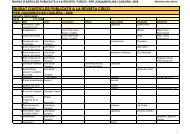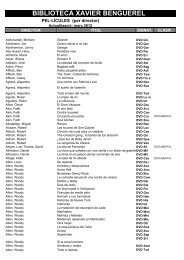Amphibians in the Region of Murcia (SE Iberian peninsula ... - Raco
Amphibians in the Region of Murcia (SE Iberian peninsula ... - Raco
Amphibians in the Region of Murcia (SE Iberian peninsula ... - Raco
You also want an ePaper? Increase the reach of your titles
YUMPU automatically turns print PDFs into web optimized ePapers that Google loves.
36 Egea–Serrano et al.Luiselli, 2000). Accord<strong>in</strong>g to <strong>the</strong>se authors, thisstatistical approach allows studied species to begrouped <strong>in</strong> a more suitable way than univariatetechniques s<strong>in</strong>ce relations between variables canbe established. Anuran and urodele species wereanalysed toge<strong>the</strong>r because no <strong>in</strong>formation is availableconcern<strong>in</strong>g <strong>the</strong> ma<strong>in</strong> differences between <strong>the</strong>setwo groups <strong>in</strong> relation to <strong>the</strong>ir biology and sensitivityto habitat degradation. The multifactorial analysisused was a multiple correspondence analysis(MCA). This statistical technique allows <strong>in</strong>formationprovided by orig<strong>in</strong>al data to be reduced to twodimensions which expla<strong>in</strong> most data variance, andassigns a new coord<strong>in</strong>ate to each case for eachdimension extracted by <strong>the</strong> analysis (Visauta, 1998).Accord<strong>in</strong>g to <strong>the</strong> values obta<strong>in</strong>ed for each dimension,species have been assigned to one <strong>of</strong> <strong>the</strong>follow<strong>in</strong>g categories, rang<strong>in</strong>g from low to high risk<strong>of</strong> ext<strong>in</strong>ction: 1. Species show<strong>in</strong>g positive values forboth dimensions (low risk <strong>of</strong> ext<strong>in</strong>ction); 2. Speciesshow<strong>in</strong>g positive values for dimension 1 and negativevalues for dimension 2 (low–medium risk <strong>of</strong>ext<strong>in</strong>ction); 3. Species show<strong>in</strong>g negative values fordimension 1 and positive values for dimension 2(medium–high risk <strong>of</strong> ext<strong>in</strong>ction); 4. Species show<strong>in</strong>gnegative values for both dimensions (high risk<strong>of</strong> ext<strong>in</strong>ction).To establish priority conservation areas from <strong>the</strong>po<strong>in</strong>t <strong>of</strong> view <strong>of</strong> <strong>the</strong> amphibian species present, <strong>the</strong>surface area <strong>of</strong> <strong>the</strong> <strong>Region</strong> <strong>of</strong> <strong>Murcia</strong> was divided<strong>in</strong>to a 5 x 5 km UTM grid. The number <strong>of</strong> amphibianspecies present for each square was determ<strong>in</strong>edaccord<strong>in</strong>g to <strong>in</strong>formation presented by Egea–Serranoet al. (2005b, 2005c). Additionally, <strong>the</strong> proportion <strong>of</strong>squares occupied by each species was calculated<strong>in</strong> relation to <strong>the</strong> number <strong>of</strong> 5 x 5 UTM squares <strong>in</strong>towhich <strong>the</strong> study area was divided. This procedureallowed to estimate species extension <strong>in</strong> <strong>the</strong> studyarea, establish<strong>in</strong>g an <strong>in</strong>dex <strong>of</strong> area occupation <strong>in</strong><strong>Murcia</strong> (D) with five categories rang<strong>in</strong>g from high tolow presence: 1. Species present <strong>in</strong> > 30% <strong>of</strong> <strong>the</strong>surface <strong>of</strong> <strong>the</strong> region. This area corresponds to <strong>the</strong>area <strong>of</strong> occupancy <strong>of</strong> a species considered as NearThreatened or Least Concern accord<strong>in</strong>g to UICNcategories (UICN, 2001). 2. Species present <strong>in</strong> 10–30% <strong>of</strong> <strong>the</strong> surface <strong>of</strong> <strong>the</strong> region. This area correspondsto <strong>the</strong> area <strong>of</strong> occupancy <strong>of</strong> a specieswhose risk <strong>of</strong> ext<strong>in</strong>ction can be considered <strong>in</strong>termediatebetween Near Threatened or Lleast Concernand Vulnerable categories, accord<strong>in</strong>g to UICN criteria(UICN, 2001). 3. Species present <strong>in</strong> 5–10% <strong>of</strong><strong>the</strong> surface <strong>of</strong> <strong>the</strong> region. This area corresponds to<strong>the</strong> area <strong>of</strong> occupancy <strong>of</strong> a species consideredVulnerable accord<strong>in</strong>g to UICN categories (UICN,2001). 4. Species present <strong>in</strong> 1–5% <strong>of</strong> <strong>the</strong> surface <strong>of</strong><strong>the</strong> region. This area corresponds to <strong>the</strong> area <strong>of</strong>occupancy <strong>of</strong> a species whose risk <strong>of</strong> ext<strong>in</strong>ction canbe considered <strong>in</strong>termediate between Vulnerable andEndangered categories, accord<strong>in</strong>g to UICN criteria(UICN, 2001). 5. Species present <strong>in</strong> < 1% <strong>of</strong> <strong>the</strong>surface <strong>of</strong> <strong>the</strong> region. This area corresponds to <strong>the</strong>area <strong>of</strong> occupancy <strong>of</strong> a species considered Endangeredaccord<strong>in</strong>g to UICN categories (UICN, 2001).Consider<strong>in</strong>g <strong>the</strong> calculated amphibian distributiondata, number <strong>of</strong> species per square and <strong>the</strong>previously calculated risk <strong>of</strong> ext<strong>in</strong>ction for eachspecies, a biological value was calculated for each5 x 5 km square through <strong>the</strong> expression:(MCA i+D i)+Spp jwhere MCA iis <strong>the</strong> risk <strong>of</strong> ext<strong>in</strong>ction for species i, D iis <strong>the</strong> distribution <strong>of</strong> species i <strong>in</strong> <strong>the</strong> <strong>Region</strong> <strong>of</strong><strong>Murcia</strong>, and Spp j<strong>the</strong> number <strong>of</strong> amphibian speciesfor j square.Squares show<strong>in</strong>g values higher than <strong>the</strong> 75 thpercentile for this <strong>in</strong>dex were selected as priorityconservation squares.Statistical analysis were performed with <strong>the</strong>SPSS ® statistical package.ResultsThe scores for <strong>the</strong> <strong>in</strong>dependent variables for <strong>the</strong>amphibian species <strong>in</strong> <strong>the</strong> <strong>Region</strong> <strong>of</strong> <strong>Murcia</strong> arepresented <strong>in</strong> table 2. The results provided by multiplecorrespondence analysis have enabled identification<strong>of</strong> three groups <strong>of</strong> species (fig. 1). Table 3shows <strong>the</strong> scores for each variable <strong>in</strong> each dimensionextracted by <strong>the</strong> MCA. Breed<strong>in</strong>g habitat comb<strong>in</strong>ed<strong>the</strong> highest value for dimension 1 (0.770) and<strong>the</strong> lowest for dimension 2 (0.067), whereas speciespresence presented <strong>the</strong> lowest value for dimension1 (0.682) and <strong>the</strong> highest for dimension 2(0.911). This implies that <strong>the</strong> ma<strong>in</strong> variables arrang<strong>in</strong>gspecies through dimension 1 and dimension2 <strong>in</strong> <strong>the</strong> <strong>Region</strong> <strong>of</strong> <strong>Murcia</strong> are, respectively,breed<strong>in</strong>g habitat and species presence.Table 4 shows <strong>the</strong> values obta<strong>in</strong>ed for variablesrisk <strong>of</strong> ext<strong>in</strong>ction and extension <strong>in</strong> <strong>the</strong> study area foreach amphibian species.The 5 x 5 km UTM squares show<strong>in</strong>g biologicalvalue <strong>in</strong>dices higher than <strong>the</strong> 75 th percentile wereconsidered as priority conservation areas. The totalnumber <strong>of</strong> such areas added up to 103 (fig. 2) andrepresented 16% <strong>of</strong> <strong>the</strong> surface <strong>of</strong> <strong>the</strong> <strong>Region</strong> <strong>of</strong><strong>Murcia</strong>.DiscussionAlthough Andreone & Luiselli (2000) <strong>in</strong>dicate thatboth univariate and multivariate methodology sufficientlycharacterise <strong>the</strong> conservation status <strong>of</strong> aspecies group, multivariate analysis alone wasused <strong>in</strong> <strong>the</strong> present study as univariate analysis isconsidered to have <strong>the</strong> disadvantage <strong>of</strong> not establish<strong>in</strong>grelationships between variables and <strong>the</strong>reforenot realistically rank<strong>in</strong>g <strong>the</strong> studied speciesaccord<strong>in</strong>g to <strong>the</strong>ir risk <strong>of</strong> ext<strong>in</strong>ction.The results obta<strong>in</strong>ed show that <strong>the</strong> speciesexposed to higher risk <strong>of</strong> ext<strong>in</strong>ction are thosewhich depend on <strong>the</strong> presence <strong>of</strong> permanent waterbodies to complete <strong>the</strong>ir larval development andwhich, <strong>in</strong> addition, show a restricted distribution



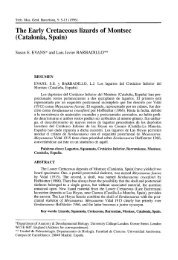
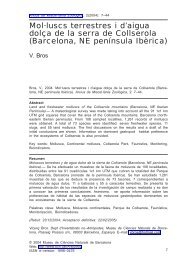
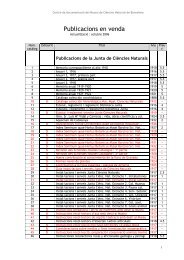
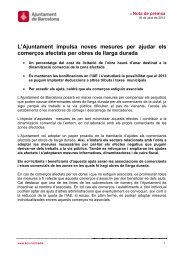
![[ pdf ] José Sanchis Sinisterra](https://img.yumpu.com/14886025/1/190x135/-pdf-jose-sanchis-sinisterra.jpg?quality=85)
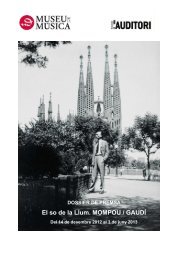
![[ pdf ] II Convenció Les veus de la gent gran 2004 - 2007](https://img.yumpu.com/14629010/1/190x182/-pdf-ii-convencio-les-veus-de-la-gent-gran-2004-2007.jpg?quality=85)

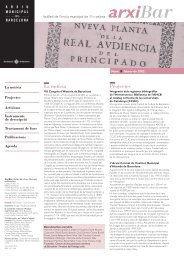

![[ pdf ] Material Escuela Pia Balmes](https://img.yumpu.com/14415004/1/184x260/-pdf-material-escuela-pia-balmes.jpg?quality=85)
